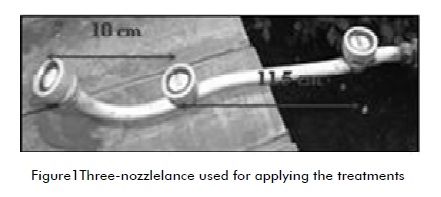
Evaluating electrolysed oxidising water as a fungicide using two rose varieties (Rosa sp) in greenhouse conditions
Belén Rocío Fernández1, Bernardo Castillo2,Eliana Díaz3 y Jesús Hernán Camacho4
1 Primacide S.A.S. bfernandezprimacide@ftenjo.com
2 Agricultural Engineer, Universidad Nacional de Colombia. M.Sc. UNICAMP, Brazil, Ph.D. Universidad Politécnica de Valencia, Spain. Associate Professor, Universidad Nacional de Colombia. bcastilloh@unal.edu.co
3 Primacide S.A.S. ediazprimacide@ftenjo.com.
4 Agricultural Engineer, Universidad Nacional de Colombia. MS.c. Agricultural Engineering, Universidad Estatal de Campinas. Assistant Professor , Universidad Nacional de Colombia. jhcamachot@unal.edu.co
ABSTRACT
The aim of evaluating electrolysed oxidising water (EOW) for controlling botrytis (Botrytis cinerea), powdery mildew (Sphaerotheca pannosa) and downy mildew (Peronospora sparsa) using two greenhouse rose varieties was to verify this new technology' s effectiveness by contrast with traditional chemical handling. Two concentrations of hypochlorous acid in EOW were produced during electrolysis in aP1200 cell and applied at three application volumes using stationary hydraulic pressure equipment. The commercial rose varieties (Rosa sp) used here were the Orlando and Versilia varieties. The EOW used was slightly acidic type C, pH 5.0, having high-oxide-reduction potential (ORP) +850 millivolts (mV). Two types of EOW were evaluated for this study: EOW C-50 (50 ppm HOCl) and EOW C-75 (75 ppm HOCl). The test results showed the feasibility of EOW as a fungicide at the volumes tested here, providing significant control of powdery mildew which has high incidence due to climatic conditions. The best disease control was achieved by applying the highest volume; however, some curled leaflets appeared with this application.
Keywords: Electrolysed oxidising water, application volume, hypochlorous acid concentration, powdery mildew, downy mildew, greymould, roses.
Received: May 6th 2010
Accepted: July 15th 2011
Introduction
Colombia is one of the Latin-American countries having the most diverse varieties of flowers due to its geographically strategic location. The planted area is close to 72.7 km2, representing about 182,000 direct jobs; it is considered to one of the most important sectors for producing foreign exchange. Colombia is currently the second largest flower exporter in the world; roses account for about 30% of the country' s total production figures Asocolflores, 2007)
Several limitations affect rose growing, including fungal diseases that harm plant development and production, the most important being downy mildew (Peronospora sparsa) (Mendoza et al., 2005), powdery mildew (Sphaerotheca pannosa) and botrytis (Botrytis cinerea) (Pasini et al., 1997).
Controlling such diseases in floriculture is typically done with the repeated and constant application of chemicals containing active toxic ingredients for applicators and the environment thereby forcing the use of personal protective equipment and environmental implements (Mendoza et al., 2005); such control leads to ever increasing production costs.
Electrolyzed oxidizing water (EOW) is a new technology that could respond to the search for economically effective and environmentally friendly pest control. This technology is produced through the principle of electrolysis of saline water and sodium chloride (NaCl) in which a flow of electric current is passed through two electrodes in compartments separated by a membrane regulating the passage of ions (Kim et al., 2000; Buck et al., 2003). The anode attracts water electrons from the cathode when the electrodes are electrically charged; At the end of the process, water having low electrode concentration is obtained at the anode and water having high electrode concentration at the cathode. The former, called electrolysed oxidising water (EOW), has high electron activity due to its increased oxidative capacity and, when searching for electrical balance has the property of taking electrons from the organisms which they come into contact with (Kohno, 1996).
EOW thus has high fungicidal activity when coming into contact with plant surfaces. Buck et al., 2002 and Buck et al., 2003have reported an overall reduction in the germination of thin-walled fungal species' spores, such as Botrytis cinerea and Moniliniafructicola, which were eliminated from contact with EOW at intervals of less than 30 seconds, while thick-walled fungal species, such as Curvularia sp and Alternaria panax required more time for germination to become significantly reduced. Fujiwara et al., 2009 and Guentzel et al., 2011 were able to control powdery mildew (Sphaerotheca fuliginea Pollacci) on cucumber leaves (Cucumis sativus L.) and Botrytis cinerea on strawberry plants (Fragaria sp.)in high volume foliar applications.
Kohno (1996) found that EOW did not affect human skin cells and plant cells as they have thicker and harder walls than pathogencells. Target plant material susceptibility to this condition should thus be evaluated when considering hypochlorous acid at a slightly acidic pH. However, Buck et al.,2003, have argued that applying foliar EOW may be safe for a variety of ornamental plants in greenhouse conditions, while Guentzel et al., 2011, have also considered the phytotoxicity caused by foliar applications of EOW to be negligible at 50 and 100 ppm total residual chlorine on strawberry plants.
This study was aimed at evaluating the effect of electrolysed water as a fungicide for controlling major diseases caused by fungi that affect roses grown in greenhouses on the Savannah around Bogotá.
Materials and Methods
The tests were carried out during the second half of 2007 on a farm producing roses for export, located in Tenjo, Cundinamarca.
Application equipment
EOW applications were made weekly using stationary hydraulic equipment with a 2.6 kW capacity 37.85 L•min-1 BEAN pressure pump powered by a 3.58 kW, 1,700 rev•min-1 AC motor. 4.1 MPa 100 m length hose with pressure regulator and four outputs for application nozzles was used. The lance had three nozzles (Figure 1); three types of nozzle were used, identified as D-35 (one hole), C-35 (two holes) and B-7 (three holes);1.7 MPa nozzle flow was 2.8, 4.9 and 8.0 L•min-1, respectively.

The equipment used for applications had1,100 L tank capacity. The tank had been previously washed with EOW A-100 (at pH 1.7 to 2.4,+1160 mV ORP and 100 mg•kg-1 HOCl) to remove chemical residues and thus avoid possible alteration of treatment water properties.
Plant material
Two commercial varieties of rose were evaluated whose rootstock is natal briar: Orlando and Versilia. The first was a hybrid tea type, having6 cm hot pink flower bud and 60-70 cm stem length. The second variety was salmon pink, having 70 cm average stem length and 6 cm flower bud. The product was applied to the Orlando cultivar for 11 weeks and for 7 weeks to Versilia. The plants were kept in typical environmental conditions in a climate-controlled greenhouse system by using mechanically operated curtains and ducts closing zenith openings.
EOW application
The EOW types applied here were: C-50 water (50 mg•kg-1 Cl)and C-75 water (75 mg•kg-1 Cl) at pH 5.0, +850 mV ORP (oxidation/reduction potential). This type of C water has a slightly acid EOW, Kitamura et al.,(2009). Water was applied for a constant period of 1.9 min per bed with the abovementioned flows. Application bed volumes were 5.3 L (treatment V1), 9.3 L (V2) and 15.2 L (V3).pH and ORP measurements perwater production plant and out of the nozzles were recorded for every application. A Hanna H198128 hand-held pH-meter (±0.01precision)and ORP measurements with Hanna H198120 precision ± 2 mV were used for obtaining these records.
EOW was applied weekly in the mornings using a technique in which the lance was moved in an arc, starting from the bottom and spraying upwards towards the canopy of the plants for treating each side of the bed, taking care that water spray was deposited on the upper and lower surfaces of the leaves and buds of the plants. A commercial non-ionic surfactant was used to reduce water slip on leaves and allow greater coverage.
Conventional fungicides were applied weekly to control beds in a rotation scheme according to plant health. Tebuconazole and triadimenol were used for controlling Sphaerothecapannosa(0.7 cm3•L-1 water dose), dodemorph acetate for Spiroxamina(0.35 cm3•L-1 water), carbendazim(2.5 cm3•L-1 water),boscalid(0.35 cm3•L-1 water), fludioxonil 1.0 g•L-1 water) and ciprodinil(0.5 g•L-1 water) for Botrytis cinerea and azoxystrobin (0.5 g•L-1 water), metalaxyl-M(6 g•L-1 water), triflumizole (1.5 cm3•L-1 water) for Peronospora sparsa with the same water application volumes.
Evaluating treatments
The beds' health was monitored after each application by quantifying the incidence of the three diseases and powdery mildew severity. The susceptibility to treatment compounds on plants was also evaluated by measuring the presence of curling leaflets and foliar physicochemical analysis. These tests were conducted in the greenhouse on random samples of foliar material from the middle third of the plants in each bed before starting EOW application and after completing all applications.
The incidence of disease was assessed as the percentage of plants affected by such disease in the population being evaluated and severity affecting a plant on a scale of 0 to 5(the lowest value = 0% incidence and the greatest= 100%).
Experimental design
A 3² factorial design was used for data analysis, two factors having three levels and three replications. For "Water", two of the levels were the EOW types and the third was the chemical used for the control treatment. For "Volume", the three levels were the V1, V2andV3 application volumes. Multivariate analysis of variance (GLM model) was used and to study the differences between factor levels using the LSD method.
Results and Discussion
Orlando variety
Only powdery mildew incidence was significant regarding the three diseases evaluated, since downy mildew and botrytis presence during the analysed period was very low in all treatments (less than 1%). There was no experimental evidence of preventative action by the treatments being used since climatic conditions during most evaluation times were not conducive to downy mildew or botrytis sporulation.
Table 1 shows the significant effect of Water and Volume on powdery mildew incidence at 5% probability level, as well as their interaction.

Figure 2 shows that EOW treatment had lower powdery mildew incidence compared to treatment that included conventional fungicide rotation.
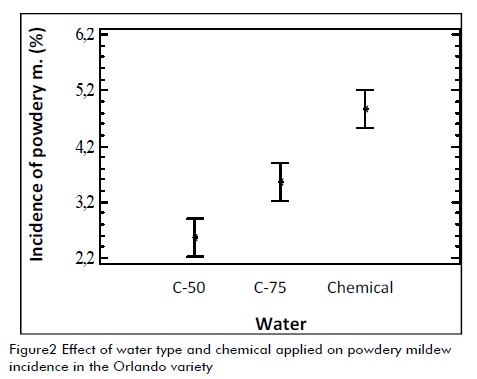
C-50 EOW led to better control than C-75 (being significant at 95% probability). In terms of liquid application volume, Figure 3 is conclusive in showing that the largest volume(15.2 L per bed) led to better control of this disease, while there was no difference between the two lower volumes regarding the average of all liquids used.
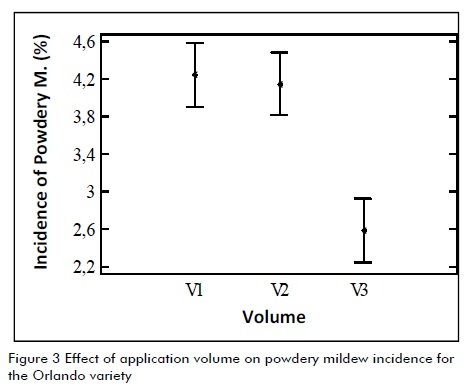
Figure 4 shows the interaction between applied water type and volume. The best control was achieved by using EOW C-50 and a higher application volume, although lower volumes could also be used for this EOW to accomplish such control.
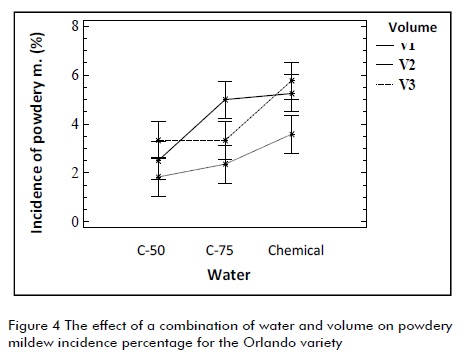
The fact that EO C-50 attained the best control was not easy to explain since, according to several authors (Al-Haq, et al. 2005; Liao, et al. 2007; Cui, et al. 2009),EOW' s bactericidal and fungicidal effect lies in the combined action of high ORP, low pH and free available chlorine concentration (as molecular chlorine or hypochlorous acid) which, in this case, was the only difference between two types of water.C-75 water having higher free chlorine should thus have been more fungicidal and its action by contact fully supported the best result for the highest application volume.
Yamaki (1998) quoted by Al-Haq et al.,(2005)managed to control powdery mildew for more than two weeks in cucumber, the same as Müller et al.,(2003)did for several weeks in Gerbera jamesonii (an ornamental specie) in greenhouse conditions, but as a preventative treatment rather than a curative one and as a complement to integrated management of this fungus.
While powdery mildew and botrytis incidence was very low, their behaviour was similar, as the lowest percentage for disease incidence was presented with the application of high volumes of EOW.
Applications of EOW in the Orlando variety had a statistically significant effect regarding the percentage of affected leaflets (as noted in Table 1).This increased with the use of high C-75 EOW application volumes. Figure 5 describes this and also indicates that for the smallest volume, regardless of the product used, the percentage of affected leaflets was low, and high volumes promoted the appearance of curled leaflets. However, the presence of these was transient in this variety' s cycle and, when the flower was cut, this met the export production quality standards .
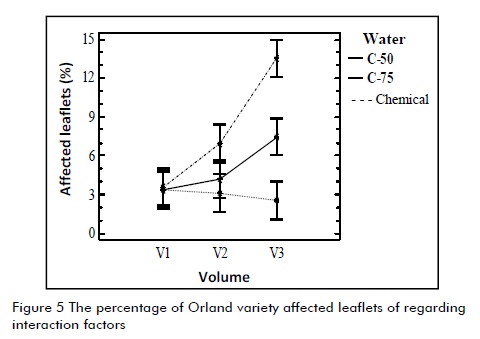
High sodium concentrations produce phytotoxicity which can be reflected in changes of the plants' characteristics which would affect their physical appearance with changes in leaf morphology, thereby reducing the active photosynthetic area and the amount of photo assimilates for proper flower bud development. However, even though some plants curled their leaflets when EOW was applied, this did not persist, thereby preserving this variety' s features without altering its yield; on the contrary, the foliage became cleared of chemical residues and looked greener.
Cabrera,(2006)when assessing sensitivity to salinity in roses, analysed the yield of dry mass, leaf damage and sodium leaf tissue concentration of roses grafted onto various rootstocks and fertilised with nutrient solutions containing increasing levels of NaCl. He found that Na and Cl accumulation and leaf damage (necrosis differential burns) in the Bridal White roses' leaf tissue were significantly influenced by rootstock type. Plants on rootstocks such as R. manetti and R.x Dr Huey showed minimal changes in sodium concentration in leaves; plants grafted onto R.x Natal Briar and R. odorata rootstocks responded by accumulating higher levels of Na, suggesting that sodium exclusion mechanisms in rose foliar tissue are significant and differentially influenced by the root (i.e. the rootstock).
Versilia variety
The combination of Water x Volume had a statistically significant effect on powdery mildew control. According to Figure 7, all treatments led to below 5% incidence. Again, the C-50 x V1 interaction had the best effect on controlling powdery mildew compared to any combination of chemical treatments.

Volume had a statistically significant effect on downy mildew incidence although, as shown in Figure 8,this accounted for a very small percentage of the disease. There was higher incidence with the lower volume compared to the other two.
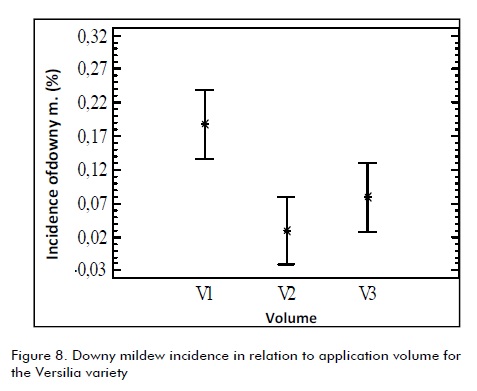
Botrytis incidence was very low for the two varieties analysed, which may have been due to EOW properties in removing any outbreak or that EOW created a healthier environment around plants promoting good growth and a reduction of spores in the environment.
Versilia plants' sensitivity to water compounds was responsible for ending EOW application since (as shown in Figure 9) it increased significantly as time elapsed. Statistical analysis confirmed this and foliar analysis showed that EOW applications produced sodium concentrations above the allowable threshold of 200 ppm Na, according to Calderón (2001);the C-50 x V1 treatment thus had the closest value to 200 ppm sodium and levels above 200 ppm Nafor C-75 x V3.
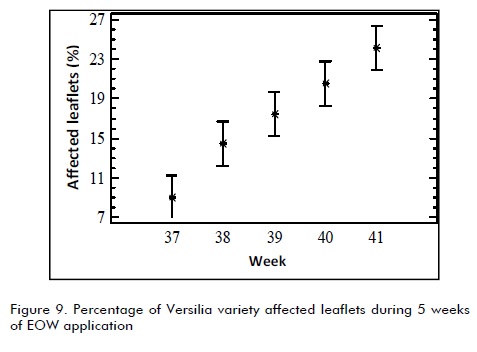
Conclusions
Slightly acidic EOW, type C, as used in the trials, had fungicidal properties that controlled powdery mildew incidence in Orlando and Versilia varieties. The application having the highest volume (V3) assured better foliage coverage, thereby achieving better control of this fungus compared to the other volumes. However, volume V1 and V2 coverage produced good pathogen control, resulting in less cost, less application time and lower incidence of ccomponents which may or may not be susceptible rose varieties. Downy mildew incidence has the same trend in the Versilia variety.
The EOW C-50 resulted in better powdery mildew control than EOW C-75 and conventional chemicals with the added advantage of producing less phytotoxic effects in the two varieties of roses studied regarding EO C-75.
The best powdery mildew control for the two varieties was achieved with a combination of EOW C-50 and V1 application volume (i.e. 5.2 L per bed) without presenting phytotoxicity problems regarding the foliage and the varieties' growth being affected.
Recommendations
EOW in a greenhouse environment eliminates the spread of spores or effects on other plants. An application technique such as a thermo nebulisation should be developed as it does not spray directly onto plants to obtain high disease control effectiveness with no chance of affecting plants' sensitivity regarding water components.
Evaluation should include new electrolytic cells, with lower chlorine consumption and more efficiency regarding electrolysis at negligible sodium ion concentrations.
A susceptibility test should be done prior to applying EOW to a specific variety of rose.
Slightly acid EOW can replace part of the traditional chemical application when controlling diseases in roses which could result in greater efficiency at lower costs, besides decreasing risks to human health.
This type of research should be continued for establishing EOW applicability in other varieties and plants.
Because EOW contains chlorine and an electron capability that can easily be altered by environmental and mechanical conditions, it should be kept at low temperatures and repeated oxygenation and prolonged storage time should be avoided.
References
Al-Haq, M.I., Sugiyama, J., Isobe, S., Applications of electrolyzed water in agriculture & food industries., Food Sci. Technol. Res., 11 (2), 2005, pp. 135-150.
Asociación Colombiana de Exportadores de Flores., Floricultura colombiana Estadísticas, 2007, Bogotá.
Buck, J.W., Van Iersel, M.W., Oetting, R.D., Hung, Y.-C., In Vitro Fungicidal Activity of Acidic Electrolyzed Oxidizing Water., Plant Dis. 86, 2002, pp. 278-281.
Buck, J.W., Van Iersel, M.W., Oetting, R.D., Hung, Y.-C., Evaluation of acidic electrolyzed water for phytotoxic symptoms on foliage and flowers of bedding plants., Crop Protetion, 22, 2003, pp. 73-77.
Cabrera, R., Consideraciones sobre nutrición mineral y fertilización en rosas., Avances sobre fertirriego en la floricultura colombiana, Universidad Nacional de Colombia, Bogotá, 2006.
Calderón, S., Muestreo foliar en rosas., Bogotá, Colombia, 2001.
Cui, X., Shang, Y., Shi, Z., Xin, H., Cao, W., Physicochemical properties and bactericidal efficiency of neutral and acidic electrolyzed water under different storage conditions., Journal of Food Engineering, 91, 2009, pp. 582-586.
Fujiwara, K., Fujii, T., Park, J., Comparison of foliar spray efficacy of electrolytically ozonated wáter and acidic electrolyzed oxidizing wáter for controlling powdery mildew infection on cucumber leaves., Ozone: Science & Engineering, 31, 2009, pp. 10 - 14.
Guentzel, J.L., Callan, M.A., Emmons, S.A., Dunham, V.L., . Evaluation of electrolyzed oxidizing water for phytotoxic effects and pre-harvest management of gray mold disease on strawberry plants., Crop Protection in press, 2011.
Kim, C., Hung, Y., Brackett, R.E., Efficacy of electrolyzed oxidizing (EO) and chemically modified cater on different types of foodborne pathogens., International Journal of Food Microbiology, 61, 2000, pp.199-207.
Kitamura, T., Todo, H., Sugibayashi, K., Effect of several Electrolyzed Waters on the Skin Permeation of Lidocaine, Benzoic Acid and Isosorbide Mononitrate., Drug Development and Industrial Pharmacy, 35, 2009, pp. 145-153.
Kohno, H., Agricultural practice using super-electrolyzed water., Rural Culture Association (Nobunkyo), Japan,1996.
Liao, L.B., Chen, W.M., Xiao, X.M., The generation and inactivation mechanism of oxidation-reduction potential of electrolyzed oxidizing water., Journal of Food Engineering, 78, 2007, pp. 1326-1332.
Mendoza, D., Piedrahita, A., Ramírez, E., Estudio económico comparativo del control manual vs. el control químico de Peronospora sparsa en rosa sp., Programa Agronomía Universidad de Caldas, Manizales, Colombia, 2005.
Mueller, D.S., Hung, Y.-C., Oetting, R.D., van Iersel, M.W., Buck, J.W., Evaluation of Electrolyzed oxidizing water for management of powdery mildew on Gerbera Daisy., Plant Dis., 87, 2003, pp. 965-969.
Pasini, C., D' Aquila, F., Curir, P., Lodovica, M., Effectiveness of antifungal compounds against rose powdery mildew (Sphaerotheca pannosa var. rosae) in glasshouses., Crop Protection ,16 (3), 1997, pp. 251-256